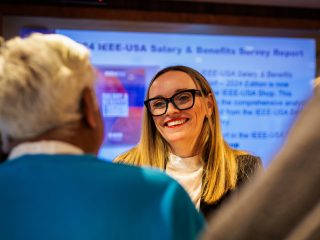Bridging the cyber generation gap is a precondition for resilience in our complex era. Leaders must treat it as a strategic security priority—not an HR issue.
By Caroline Stokes, Author of AfterShock to 2030: A CEO’s Guide to Reinvention in the Age of AI, Climate, and Societal Collapse
When Paul Nakasone—the man who led the NSA and U.S. Cyber Command—says we have a generational problem, we should pay attention.
During DEF CON week in Las Vegas, he spoke about the age differences he observed between workers in the US tech sector and the federal government, according to WIRED.
“Every place that I went to, I was twice the age of the people that talked to me. And then when I came back to DC… I was one of the younger people there. OK, that’s a problem,” Nakasone said.
The ex-NSA chief was pointing to a dangerous gap in the systems protecting our nations, our critical infrastructure, and our ability to respond to crises.
In my book AfterShock to 2030, I call this the moment when leaders must learn to reprogram the nervous system of leadership—not just for ordinary change, but for mega-change. We’re in an AfterShock era where climate disruption, AI, and geopolitical instability demand a new kind of cognitive scaffolding, emotional intelligence, and speed.
The Divide We Don’t Talk About
Across critical industries—from energy grids to AI governance— two “human” worlds co-exist:
- Younger, tech-native teams: move fast, adapt instantly, embrace disruption, fluent in AI and agile systems.
- Older, experienced leaders: carry the hard-won caution of having seen “how things blow up”—economically, politically, and physically.
The problem? These two groups are not speaking the same language, which means that in high-stakes environments, that gap directly impacts operational success.
In my AfterShock to 2030 chapter Mea Culpa, I explore how leaders must own their blind spots before rebuilding trust—and generational misalignment is one of the biggest.
Why This Gap is Both a National and Global Risk
In my podcast conversation this week with Peter Warren, chair of the Cyber Security Research Institute, we discussed how the challenge is not just about skills or tools — it’s about awareness of one’s own exposure, vulnerability, and responsibility.
When the generations don’t integrate, we get:
- Speed without stability: innovation moves ahead without guardrails, opening up new vulnerabilities.
- Stability without adaptability: risk controls slow response to emerging threats.
- Communication breakdowns: policy language and code logic fail to connect.
This is exactly what I map out in my chapter Designing for Intelligence in the AfterShock Era. If we don’t consciously engineer decision-making systems that integrate both perspectives, we leave open doors for failure.
The Nervous System Divide
Polyvagal theory, which I detail in my chapter Nervous System First, gives us a deeper view of why these clashes happen.
- Older leaders: shaped by past crises, they are primed for hyper-vigilance or shutdown when risk is detected, driving defensive strategies.
- Younger leaders: without those imprints, they operate in an uninhibited, more mobilized, optimistic state, willing to leap and iterate under pressure.
When these physiological states collide without awareness:
- Younger teams see older ones as paralyzed by fear
- Older teams see younger ones as reckless and overly enthusiastic.
Both perspectives are incomplete—they’re reading nervous system cues without the translation and biases become forged. This is why AfterShock to 2030 calls for leaders to “hack their own operating system” before trying to change the organizational one.
From Mistrust to Mutual Respect
The optimal state for collaboration is the ventral vagal state, where trust, engagement, and creative problem-solving thrive.
Bridging this divide isn’t just about mentorship or “reverse mentorship”. It requires systems that co-regulate teams back into this state under stress. In the chapter The Rise of the Chief Coaching Officer, I outline how embedding this role creates human infrastructure to bridge such divides in real time.
The Generational Systems Bridge Framework
The approach I coach closes the generation gap by turning differences into a strategic advantage:
- Understanding & Appreciating
- Older generations learn the values, language, and decision speed of younger, tech-native peers.
- Younger generations grasp the weight of regulatory complexity and the cost of missteps at national scale.
- Translation & Collaboration
- Build “translation layers”—roles dedicated to bridging technical and policy perspectives.
- Run simulations where mixed-generation teams jointly solve high-risk scenarios.
- Neuro-Cultural Regulation
- Train leaders to recognize their own and others’ nervous system shifts.
- Use co-regulation protocols to restore collaboration during high-stress events.
- Embedded Change
- Make generationally mixed teams a requirement for incident response and strategic planning.
- Track collaboration outcomes alongside technical KPIs.
A Call for Institutions to Upgrade Their Leadership
From global industrial technology leaders to national standards authorities and infrastructure and automation enterprises, the same generational tensions shape the safety, speed, and resilience of our systems.
This is why AfterShock to 2030 is not just a book, but a blueprint for leaders to survive and thrive in this exact environment.
The Cost of Doing Nothing
If we ignore this gap:
- Critical infrastructure remains vulnerable.
- Cybersecurity responses lag behind threats.
- Policy and technology stay misaligned.
What may traditionally be seen as a workforce or culture challenge is, I believe, a national and global resilience and security challenge. As I write in AfterShock to 2030, “The most dangerous assumption in business today is that we can solve 21st-century problems with 20th-century thinking.”
A Call to Act
Nakasone’s warning is clear: the divide is real, and the stakes are high. The question for leaders is whether they will treat it as an HR issue; or as the strategic security priority it actually is.
Bridging the cyber generation gap is a precondition for resilience in the age of AI, climate disruption, and accelerating geopolitical risk.
AfterShock to 2030 exists to give leaders the tools, frameworks, and mindset shifts to do exactly that—before the next shock makes the gap unbridgeable.
Caroline Stokes is a leadership strategist, executive coach, and author of AfterShock to 2030: A CEO’s Guide to Reinvention in the Age of AI, Climate, and Societal Collapse (Broad Book Press, 2025.) She works with people in governance, Fortune 500 companies, and critical infrastructure leaders to close generational, cultural, and systemic divides and move individuals, teams, companies, and industries forward.




